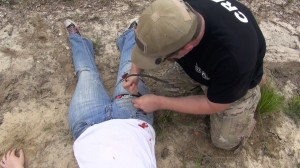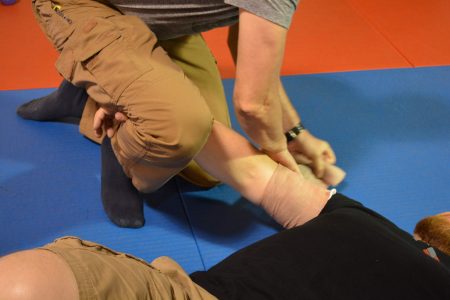(UPDATED 01/23/23) “Who put this tourniquet on him?” asked the trauma doctor in the Emergency Room. “Brad. It was Brad.” replied the female ranch hand who had driven the patient to the hospital. “Well, you can tell him that he did a good job and that he saved his life.” the doctor assured the young woman.
Student of the Gun has been teaching the Beyond the Boo Boo traumatic medical training class since 2011 and we have received innumerable reports from our graduates who had to use their training. However, we have never had someone use the skill and gear from the class to save a life as quickly as we did last summer. It was only eight days after the class that Brad was called upon to save a life.
During the after action report from the above incident, we learned that the patient had been knocked down and stepped on by a steer on the ranch. The steer’s hoof cut deep into his arm and severed the brachial artery. Our graduate was there and applied a tourniquet. The ER doctor further elaborated, “If he (the patient) had bled for another minute, he would not be here today.”
When I attended USMC Infantry School, our first aid training mirrored that of the Red Cross civilian program. While battlefield trauma was talked about, little emphasis was put on self-aid and buddy-aid. The primary care giver on the battlefield was the Navy Corpsman and your first aid kit was carried merely to give the Corpsman some extra gear with which to work. Ways to improvise a tourniquet were mentioned but only with the caveat … “as a last resort, after all other means have failed.”
During the Cold War Era with few exceptions, the powers that be were more concerned with winning the next conflict with B-52 bombers and nuclear-powered submarines than infantry troops. Ground troops were considered an ancillary component to warfare, not the prime focus. As such the budgets for training and gear were sparse at best. Live-fire was limited and combat focused training was rather stagnant.
NEW!! Did you know that we now have digital training courses?
Click Here to gain instant access to Force Options: How to Defend Yourself Without a Weapon >>
Fast forward to the year 2011 and we have been in an active shooting war for ten years. This is a war where the man on the ground is now a critical player. Our nation has done an excellent job developing body armor and thus protecting our troops’ core; their torso. However, grievous life-threatening injuries in the form traumatic arm and legs wounds were taking our troopers lives too often. These were considered life-threatening but preventable injuries. By preventable, it was meant that appropriate battlefield care could save their lives.

Embracing Tourniquet Use
A dedicated Tactical Combat Casualty Care program was developed and taught to the combat troops. Rather than simply scream for the medic or corpsman, troops were taught to treat themselves and their buddies and to stem the flow of blood while waiting for professional medical aid. Pre-made tourniquets of many designs were purchased by all branches of the U.S. Military and the troops were taught how to use them properly.
On the battlefield overseas the tourniquet training battle has been won and innumerable U.S. servicemen have had their lives and limbs saved by the rapid and effective use of a tourniquet. However, here at home the only folks who seem to understand the life-saving value of the tourniquet are the vets.
It’s not just citizens who fear the tourniquet as the shadowy boogeyman; it’s also emergency medical professionals and first responders. I’ve had trained EMT’s argue that we can’t teach just anyone to use a tourniquet. Furthermore, they had argued that risks outweigh the possible benefits. Empirical battlefield evidence aside, allow me to quote from the Prehospital Trauma Life Support 6th Edition. This medical manual is the bible for SOF medics and the reference guide they use.
On page 181 of PHTLS 6th Edition the manual states… “If external bleeding from an extremity cannot be controlled by pressure, application of a tourniquet is the reasonable next step for hemorrhage control.” It continues… “Although there is a small risk that all or part of the limb may be sacrificed, given the choice of losing a limb or saving the patient’s life, the obvious decision is to preserve life.” Naturally the recommended method for patient assessment and the application of a tourniquet, if necessary, are explained in great detail in the PHTLS.
Gear Training
All gear, and that includes medical gear, requires proper training to be used effectively. Those who are serious about saving their own lives with a firearm are best served by professional training and then practice. Simply put, if an 18 year old Army private can be taught to save his buddy’s life with a trauma kit, so can any trained gun carrier.

An arterial hemorrhage on the streets of Houston, Texas or the rocky soil of Afghanistan both have the same result. In other words, the patient dies. Arterial bleeding in the arm or leg must be controlled in mere minutes (1 to 2 minutes) or the patient will exsanguinate (bleed to unconsciousness) and reach irreversible shock. Two minutes is precious little time to exhaust “all other means” and then start looking for the material to make an improvised tourniquet.
The tourniquet is not some sinister boogeyman waiting in the shadows to force amputation; it is merely a tool that can save a patient’s life and limb in the unhappy event of the traumatic injury to the arms or legs. Training and gear are available to all. The decision is yours, make an informed decision, not one based on myth or misunderstanding.
[Original Publish Date: 06/18/2014]
Have you thought about what you would do if a loved one was bleeding out right next to you? What action would you take? Let us know in the comments below.
CLICK HERE to apply to be part of The Student Lounge.
Professor Paul Markel
Latest posts by Professor Paul Markel (see all)
- Tactical Masturbation: Top 3 Stupid Human Tricks - July 8th, 2024
- Blood Trail: Fearless Fiction - June 21st, 2024
- SOTG and SB Tactical Celebrate Brace Ruling - June 20th, 2024
- Shotgun Accessories: Practical and Useful - June 14th, 2024
- Tactical Rifle Tips: Transition Drills - January 5th, 2024






If bleeding cannot be stopped by any other means, I definitely would not hesitate to use a tourniquet.
Why not use the tourniquet first? By the time you try “other means” it may be too late.
i agree with Jarrad. Unfortunately Phyllis, we’re mis-taught as a society that tourniquets are bad, and only a last resort. When do you decide it’s a last resort? If it were your femoral artery cut open would you try some other means first or go straight for the tourniquet? My money is on the tourniquet.
I remember a few years ago helping my son with his first aid merit badge. The guy teaching the class emphatically said to NEVER use a tourniquet as it will guarantee the loss of limb. Looks like I’ll be re-addressing this topic with my son. Keep up the good work guys!
I always carry a tourniquet in my blowout kit when I go the the range, but I never gave it a thought to carry one in my first aid kit in the car. I will have to correct this. Good article. Thanks
Why just in the car kit? I carry a TQ in my hip pocket as part of my EDC kit. It goes with me even places where my gun cannot.
Depends on the wound and rate of bleeding. You don’t want to use it if pressure is all you need but if that’s not stopping the bloodflow significantly and Quik Clot wont work then I’d grab the tqt out of my edc in a heartbeat. I just dont want to grab that first by rote.
Good article.
I was thinking about this. What actually IS the criteria for moving from pressure to shoving QuikClot in a wound and how long do you wait to see if that is effective before wrenching down a tourniquet?
I remember a few years ago helping my son with his first aid merit badge. The guy teaching the class emphatically said to NEVER use a tourniquet as it will guarantee the loss of limb. Looks like I’ll be re-addressing this topic with my son. Keep up the good work guys!
Depends on the wound and rate of bleeding. You don’t want to use it if pressure is all you need but if that’s not stopping the bloodflow significantly and Quik Clot wont work then I’d grab the tqt out of my edc in a heartbeat. I just dont want to grab that first by rote.
Good article.
I was thinking about this. What actually IS the criteria for moving from pressure to shoving QuikClot in a wound and how long do you wait to see if that is effective before wrenching down a tourniquet?
If bleeding cannot be stopped by any other means, I definitely would not hesitate to use a tourniquet.
Why not use the tourniquet first? By the time you try “other means” it may be too late.
i agree with Jarrad. Unfortunately Phyllis, we’re mis-taught as a society that tourniquets are bad, and only a last resort. When do you decide it’s a last resort? If it were your femoral artery cut open would you try some other means first or go straight for the tourniquet? My money is on the tourniquet.
I always carry a tourniquet in my blowout kit when I go the the range, but I never gave it a thought to carry one in my first aid kit in the car. I will have to correct this. Good article. Thanks
Why just in the car kit? I carry a TQ in my hip pocket as part of my EDC kit. It goes with me even places where my gun cannot.
As a paramedic of 40 years, a State primary instructor and an ERT medic, I would have no problem using a tourniquet for arterial bleeding (and as first line if under fire or multiple casualties present), but I have seen them misapplied and used when not needed, where they did more harm than good (and the credo is `to do no harm’). I am an advocate for `stop the bleed’ program, but people need to be taught how to evaluate and determined when they are necessary and when direct pressure, elevation and stabilization are more appropriate and not just go right to a tourniquet.
Proper training is the right answer in most cases.